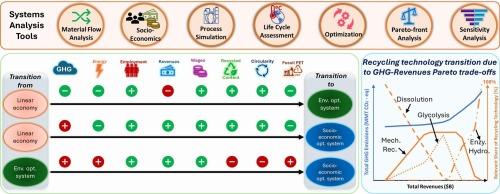美国PET包装材料在循环经济中的环境和社会经济帕累托前权衡分析
IF 9.6
1区 环境科学与生态学
Q1 ENVIRONMENTAL STUDIES
引用次数: 0
摘要
为了在塑料供应链系统中实现循环经济,各种回收技术正在兴起。然而,塑料在循环经济中的环境和社会经济权衡在系统层面上还没有得到很好的理解。特别是,将这些权衡作为报废(EOL)管理决策的功能进行量化,包括回收技术的过渡、循环度、回收含量等系统级指标以及对化石衍生塑料的需求,目前还没有得到很好的理解。本研究通过应用系统分析建模方法解决了这些研究空白,该方法利用了美国聚对苯二甲酸乙二醇酯(PET)包装供应链的物料流分析、生命周期评估、社会经济数据和系统优化技术。利用epsilon约束方法探讨了环境和社会经济影响之间的帕累托前权衡,以及社会经济影响和循环之间的权衡。帕累托前权衡分析揭示了PET包装系统EOL管理策略的转变,包括回收技术选择的变化,通过量化所研究的系统指标来帮助决策过程。从环境最优系统向社会经济最优系统的过渡导致了就业(17%)、工资(26%)和收入(6%)的增加,但也导致了全球变暖潜能值(GWP)增加65%,能源消耗增加59%,以及系统中对化石PET的依赖增加78%。最后,研究结果表明,并没有一套独特的回收技术来实现PET包装系统的可持续循环经济,而是取决于决策者的目标和系统的针对性指标。本文章由计算机程序翻译,如有差异,请以英文原文为准。

Environmental and socio-economic Pareto-front trade-off analysis of U.S. PET packaging material in a circular economy
Various recycling technologies are emerging to implement circular economy in plastics supply chain systems. However, the environmental and socio-economic trade-offs of plastics in circular economy are not well understood at a systems level. Particularly, quantifying these trade-offs as a function of end-of-life (EOL) management decisions, including transition of recycling technologies, systems level metrics such as circularity, recycled content, and the need for fossil-derived plastics are not well understood. The present study addressed these research gaps by applying a systems analysis modeling approach that utilizes material flow analysis, life cycle assessment, socio-economic data, and system optimization techniques for polyethylene terephthalate (PET) packaging supply chains in the United States. Pareto-front trade-offs between conflicting environmental and socio-economic impacts as well as those between socio-economic impacts and circularity were explored using the epsilon constraint method. The Pareto-front trade-off analysis revealed the transition of EOL management strategies for PET packaging systems, including changes in selection of recycling technologies, to aid decision making process by quantifying studied system metrics. Transitioning from environmentally optimal to socio-economically optimal systems led to increased employment (by 17 %), wages (by 26 %), and revenues (by 6 %) but also led to increased global warming potential (GWP; by 65 %), energy consumption (by 59 %), and reliance on fossil PET in the system (by 78 %). Finally, the results show that there is not a unique set of recycling technologies to achieve a sustainable circular economy of PET packaging system, instead it depends on the decision maker's objectives and targeted metrics of the system.
求助全文
通过发布文献求助,成功后即可免费获取论文全文。
去求助
来源期刊

Sustainable Production and Consumption
Environmental Science-Environmental Engineering
CiteScore
17.40
自引率
7.40%
发文量
389
审稿时长
13 days
期刊介绍:
Sustainable production and consumption refers to the production and utilization of goods and services in a way that benefits society, is economically viable, and has minimal environmental impact throughout its entire lifespan. Our journal is dedicated to publishing top-notch interdisciplinary research and practical studies in this emerging field. We take a distinctive approach by examining the interplay between technology, consumption patterns, and policy to identify sustainable solutions for both production and consumption systems.
 求助内容:
求助内容: 应助结果提醒方式:
应助结果提醒方式:


